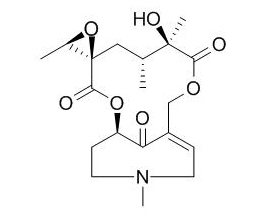Petasitenine
Petasitenine has carcinogenic activity, it also has toxicity, the toxic effect will be developed in the tissues other than the liver or in the species apart from rodents.
Inquire / Order:
manager@chemfaces.com
Technical Inquiries:
service@chemfaces.com
Tel:
+86-27-84237783
Fax:
+86-27-84254680
Address:
1 Building, No. 83, CheCheng Rd., Wuhan Economic and Technological Development Zone, Wuhan, Hubei 430056, PRC
Providing storage is as stated on the product vial and the vial is kept tightly sealed, the product can be stored for up to
24 months(2-8C).
Wherever possible, you should prepare and use solutions on the same day. However, if you need to make up stock solutions in advance, we recommend that you store the solution as aliquots in tightly sealed vials at -20C. Generally, these will be useable for up to two weeks. Before use, and prior to opening the vial we recommend that you allow your product to equilibrate to room temperature for at least 1 hour.
Need more advice on solubility, usage and handling? Please email to: service@chemfaces.com
The packaging of the product may have turned upside down during transportation, resulting in the natural compounds adhering to the neck or cap of the vial. take the vial out of its packaging and gently shake to let the compounds fall to the bottom of the vial. for liquid products, centrifuge at 200-500 RPM to gather the liquid at the bottom of the vial. try to avoid loss or contamination during handling.
Int J Mol Sci.2021, 22(16):8641.
Nutrients.2023, 15(3):753.
Agronomy2023, 13(9), 2410.
Foods.2021, 10(12):2929.
Psychopharmacology (Berl).2020, 10.1007
Front Aging Neurosci.2019, 11:230
Sci Adv.2018, 4(10)
Phytother Res.2023, 37(10):4587-4606.
Sci Rep. 2018, 462(8)
Appl. Sci.2020, 10(23), 8729
Related and Featured Products
J Toxicol Sci. 1984 May;9(2):143-9.
Some toxic properties of a carcinogenic pyrrolizidine alkaloid, petasitenine.[Pubmed:
6481824]
Some toxic properties of Petasitenine, a hepatocarcinogenic pyrrolizidine alkaloid, were confirmed in 3 parts of studies.
METHODS AND RESULTS:
Electron microscopic observation of rat liver on the stage of acute toxicity following administration of a toxic dose of Petasitenine disclosed the distinctive changes i.e., nucleolar segregation, degradation of endoplasmic reticulum such as formation of concentric whorls in the liver cells. Biochemical test for the mitochondrial function in the isolated mitochondria from rat liver cells revealed on inhibitory effects of Petasitenine in the respiratory system, indicating that minor changes of mitochondria on the pyrrolizidine alkaloid may be induced by some other indirect factor.
CONCLUSIONS:
Investigation for the effect of Petasitenine on the cell cycle of the cultured cell line from the human carcinoma showed some inhibitory effects in the appearance of cells in S-phase or M-phase, suggesting a possibility that toxicity of Petasitenine will be developed in the tissues other than the liver or in the species apart from rodents.
J Natl Cancer Inst. 1977 Apr;58(4):1155-7.
Carcinogenic activity of petasitenine, a new pyrrolizidine alkaloid isolated from Petasites japonicus Maxim.[Pubmed:
191625]
The carcinogenic activity of Petasitenine, a new pyrrolizidine alkaloid isolated from young flower stalk of Petasites japonicus, was studied in ACI rats.
METHODS AND RESULTS:
All rats that had received a 0.05% solution of Petasitenine in drinking water died or were killed in moribund condition 72 days after the start of experiment. They showed necrosis, hemorrhage, and remarkable proliferation of the bile ducts in the liver. In another group that had received a 0.01% solution, 8 of 10 animals surviving beyond 160 days developed tumors in the liver, i.e., hemangioendothelial sarcomas in 5 rats and liver cell adenomas in 5 rats, 2 of which simultaneously developed hemangioendothelial sarcomas. No tumors were observed in the livers of the control animals.



